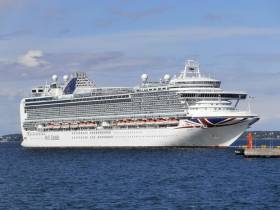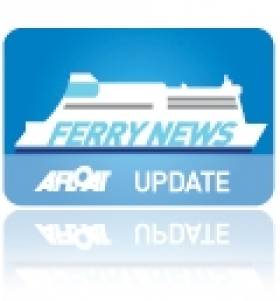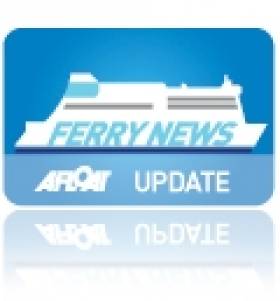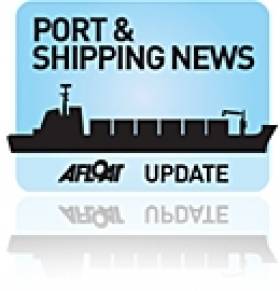Displaying items by tag: EU Sulphur Directive
Captain of Cruiseship Fined €100,000 for Using Dirty Fuel
#Cruiseliners - A captain of a cruise ship found to be burning fuel with excessive sulphur levels has been fined €100,000 (£88,500) in a Marseille court, the first such ruling in France.
The prosecution writes The Guardian was intended to signal a new seriousness in tackling pollution from cruise ships after a spot-check in March on the Azura, operated by P&O Cruises, found it contained unauthorised bunker fuel.
The American captain, Evans Hoyt, knew the fuel was illegal – it contained 1.68% sulphur, 0.18% above the European limit – and the company was using it to save money, prosecutors said during the trial.
The judge handed Hoyt a fine of €100,000, but specified that the parent company of P&O, the US-based Carnival, should pay €80,000 of the sum. The company had “wanted to save money at the expense of everyone’s lungs”, the prosecutor Franck Lagier told the court in October.
A recent report in the journal Nature attributed 400,000 premature deaths and 14m cases of childhood asthma a year to emissions from dirty shipping fuel.
A spokesman for Carnival said: “The Carnival group carries over 12 million guests on its vessels each year and takes its legal and moral obligations towards the protection of the environment very seriously indeed. We were therefore very disappointed to be prosecuted for this offence, which was based on a European law the French environment ministry had explicitly informed the cruise industry would not be applied to cruise ships and which, in any event, has still not been properly implemented. The captain was using the fuel in good faith, as directed by us, based on our understanding of the law. We have lodged an appeal and will consider the full decision of the court once it is available.”
For more including the port of Marseaille click here
Afloat adds the 3,100 passenger capacity cruiseship has visited Irish ports among them Cork (Cobh) with a first call in 2010.
A sister of the 'Grand' class ship, Carribean Princess Afloat previously covered in 2016 was then given a record fine for dumping oil using a so called 'magic pipe' within UK waters three years previously.
The cruiseship has visited Irish ports too notably in 2017 when making the most calls of any cruiseship to Dublin Port with a scheduled 13 calls alone to the capital.
Passengers Warned Ferry Fares Set to Soar in 2015 over Brussels War on Dirty Fuel
#RisingFares – According to Hellenic Shipping News, as of New Year's Day, ferry passengers are being warned to expect a sharp increase in fares in 2015 after rules curbing 'dirty fuel'.
Freight and passenger rates will jump as ferry operators pass on the costs incurred by having to meet the new regulations.
Ships in the English Channel, North Sea and Baltic Sea have been ordered by Brussels to meet strict limits on emissions, meaning that they will either have to use expensive low-sulphur fuel or install costly sulphur filters.
Emissions limit: New EU regulations on emissions could lead to a sharp increase in fares for passengers. Fuel accounts for about a third of a ferry company's overall operating costs. Industry reports say that the change in legislation could double fuel bills.
Experts have estimated the additional cost to the marine industry at about £300 million a year.
Shipping companies are making no secret of the fact that they are going to be clawing back the costs by charging their passengers higher fares.
Carsten Jensen, senior vice president at DFDS Seaways, told The Mail on Sunday that his company has already invested millions of pounds in preparing to comply with the changes. He said: 'The incoming legislation will inevitably lead to an increase in fuel costs for all shipping organisations operating in the Channel, North and Baltic Seas. 'The increase in costs will, unfortunately, need to be passed on to customers.'
P&O Ferries has estimated that its annual fuel bill will soar by about £30 million a year. The company has already announced that it is planning to recover this cost from those using its services.
Swedish shipping company Stena Line, which operates 35 vessels on 19 routes in the areas covered by the new rules, has attacked the imposition of the legislation, describing it as 'one of the largest negative political decisions taken since duty-free shopping was discontinued'.
Chief executive Carl-Johan Hagman estimated that having to use low-sulphur fuel would push up his firm's fuel bill by £41 million a year.
The UK Chamber of Shipping has warned that some ferry routes could be axed as they could cease to be economically viable. DFDS is closing its Portsmouth to Le Havre route this week.
There are additional fears that supplies of low-sulphur marine gas oil will be too low to meet the suddenly increased demand.
Lloyds List Top 100: Stena Sphere's Dan Sten Olsson
#StenaSphere – Swedish shipping magnate Dan Sten Olsson of Stena Sphere group, remains quite broad and despite facing several challenges it certainly remains innovative, writes LloydsList.com in their Top 100.
The Stena Sphere, the name the company uses for the group of company's owned by Dan Sten Olsson's family, consists of businesses focused on ferries, (which celebrated a 50th anniversary in 2012) tankers, gas carriers and offshore platforms. It is also active in scrap metal and real estate.
In the tanker business, Concordia Maritime, the only part of the Stena companies that is listed, has had a bumpy ride. The recent announcement that it has formed a pool with Stena Bulk says a lot about the company's dependency on the latter business.
Stena Bulk has been forced to continue its adaption this year, strengthening its activities in bio oil shipping, as well as its activities linked with Angolan oil major Sonangol.
Stena Bulk has also joined the fast-growing World Ocean Council, a global alliance involved in corporate social responsibility, sustainability and the oceans.
The other challenges in the group are in Stena Line, the north European ferry operator that will have to deal with a switch to low sulphur fuel as of January 1, 2015.
For more on the Lloyds List editorial, which examines Stena's role on the issue of the EU Sulphur Directive's impact on its North Sea, English Channel and Baltic Sea ferry network operations, click HERE.
New Sulphur Rules Cause Closure of Last UK-Scandinavian Ferry Service
#RouteClosure - EU sulphur rules to be introduced in 2015 have ultimately led to the closure in advance of the only ferry service linking between the UK and Scandinavia, writes Jehan Ashmore.
The DFDS Seaways service operated by ro-pax Sirena Seaways made her final sailing yesterday from Harwich to Esbjerg in Denmark, marking an end of era dating to 1875.
The Danish operators for a brief period in 2011 also operated Irish Sea services, had closed the North Sea route due to the inability to sustain substantial additional costs that would be accrued when the EU's new sulphur directive environmental law is effective from 1 January, 2015.
The North Sea route had been struggling in recent years with high costs and low utilization as passengers and freight switched to longer distance road transport. Another blow was the loss of tax-free sales and increasing competition from low-cost airlines with passenger totals falling from 300,000 to around 80,000 and a declining industrial cargo market between the two countries.
The service which was operated by the 22,000 tonnes ro-pax Sirena Seaways since 2003, is to be deployed to another DFDS service linking Estonia and Sweden.
Stena Line freight customers which had an agreement to use the DFDS route from the UK to Scandinavia will instead be focused on the operators other East England route, Immingham-Esbjerg. The 18 hour route is serviced by a pair of modern ro-ro vessels.
The emissions regulations will also have a significant economic effect for Stena Line. Their Scandinavian ferry operations will face more than £100,000 per day in extra fuel costs or around £41m annually having to use more expensive low sulphur fuel.
Sulphur Regulations to Force Changes at Stena Line
#EUsulphurDirective - The EU's new sulphur directive for shipping traffic within the North European Sulphur Emission Control Areas (SECA), which comes into force on 1 January 2015, is due to have a significant economic impact on Stena Line's business.The Swedish owned ferry company is to face more than £100,000 per day in extra fuel costs.
The new sulphur directive has been in the planning stage for a number of years and its negative economic impact, a significant increase in fuel costs, was one of the key drivers behind Stena Line's decision to implement a company-wide two year Change Programme in 2013.
One of the key objectives of the Change Programme was to improve Stena Line's performance by £100m to help put the company on a more secure financial footing post- directive implementation. The rolling programme has resulted in a number of steps being taken including the reduction from two vessels to one on the Trelleborg-Sassnitz route and the fact that Stena Line is now being forced to increase its prices to freight customers as a direct result of the change in legislation.
"From an economic perspective, this is one of the largest negative political decisions taken since tax-free shopping was discontinued. As a company we are very supportive of environmental improvement regulations as long as the changes are the same for everyone and are implemented at a rate which we and our customers can handle but unfortunately this is not the case with the new sulphur rules. Ultimately, the resultant increase in fuel costs negatively impacts on North European export and import trade because a significant proportion of these trades are facilitated by sea transport", said Stena Line's CEO Carl-Johan Hagman.
For Stena Line, the changes mean a direct increase in fuel costs of more than £100, 000 per day, or around £41m annually as a result of having to use the more expensive low sulphur fuel.
"If you look at the freight side of our business for example, we are going to have to increase prices by around 15%. As a business, we are committed to delivering the same quality and service and we will continue our efforts to offer environmentally effective transports. This means that unfortunately we are left with no alternative but to pass on the imposed increase in costs to our freight customers", said Carl-Johan Hagman.
Since 2005 Stena Line has worked diligently to reduce its environmental impact with a comprehensive Energy Saving Programme which has successfully reduced vessel energy consumption by approximately 2.5% every year since 2005.
In parallel with the change to low-sulphur oils, Stena Line is also running a number of projects to look at alternative fuels and different techniques for emission purification.
"In early 2015 we will be starting a trial with methanol as a potential fuel on one of our ferries. At the same time we will be taking a closer look at deploying scrubber technologies and also looking at LNG as a possible fuel. Naturally, converting and rebuilding our ferries will both take time and require a significant investment on our part", concluded Carl-Johan Hagman.
IMDO Shipping Review: EU Sulphur Directive in Maritime Industry,FTA Seek Postcode Reassurance,CEF Transport Calls on Proposals and much more
#Ports&Shipping –The latest IMDO Weekly Shipping Market Review includes the following stories as detailed below.
Irish Maritime Regulation: Directive 2012/33/ EU on Sulphur Emissions in the Maritime Industry- Air pollutant emissions from maritime transport can be transported over long distances and thus increasingly contribute to air quality problems in the EU.
The Thematic Strategy on air pollution from 2005 concluded that sulphur emissions from shipping were forecast to exceed those from all land-based sources in the EU by 2020. Further action is therefore needed to improve human health and the environment.
For latest responses to the Directive from three shipping companies, download the IMDO PDF below and for a copy of the Directive in the Irish Statute book, click HERE.
Irish Ports & Shipping News: FTA seeks reassurance over new postcodes - The Freight Transport Association of Ireland (FTAI) has sought reassurances that Eircode, Ireland's new postcode system, is fit for business. This follows concerns from members that the system appears optimized for the delivery of postal mail, but is not adequate for location or navigation purposes, or for the 'smart' economy. The post code will consist of seven-characters, including a routing key and an identifier unique to each mailing address. The system is designed to be a smart locater capable of identifying any address in the country and is hoped to be rolled out by 2015.
EU Funding: €11.93 billion allocation for 2014 CEF Transport Call - The 2014 CEF Transport Calls for Proposals, published on 11 September 2014, are the first calls under the successor programme to TEN-T.The main objective of CEF Transport is to help complete the TEN-T Core Network and its Corridors by 2030. A total budget of €26.2 billion has been allocated to co-fund TEN- T projects in the EU Member States for the period 2014-2020: more than three times the amount allocated to the predecessor TEN-T Programme (2007–2013).
For more on each of the above and other stories click the PDF downloadable IMDO Weekly Markets Review (Week 37). In addition to coverage on Afloat.ie's dedicated Ports & Shipping News section.
#ShipSulphur - The European Union's Sulphur Directive represents the biggest challenge for the short-sea shipping sector in the coming years.
New rules on sulphur emissions to be introduced in 2015 will reduce ship's competitiveness against the truck transportation and so industry and governments must act quickly.
The Shortsea Promotion Centre of Norway which recently held a mini-conference entitled "Sulphur Directive in 2015 and Norwegian short sea shipping" was attended by delegates from nearly all ship owners operating liner services to Norway.
The main focus of the event was how participants can meet the challenges of the Sulfur Directive and turn it to their advantage. To read more on the impacts of the directive facing the industry visit this link.






























































